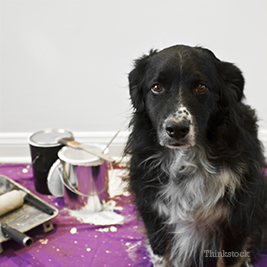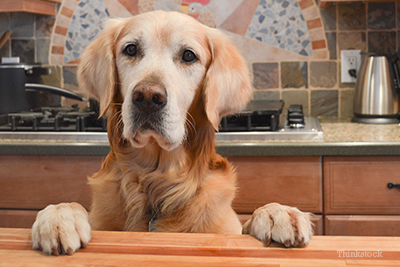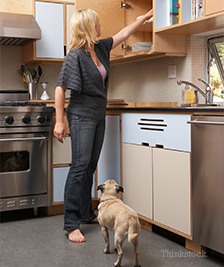
As an emergency critical care veterinary specialist and toxicologist, I see a lot of poisoning cases in the ER. Some of the most life-threatening and costly are poisoning cases that cause acute kidney injury (AKI). Even with treatment, AKI can result in chronic scarring or permanent damage to the kidneys, predisposing your dog to chronic kidney disease (CKD). That’s why it’s important to be aware of these potential kidney toxins to keep your dog away from.
Depending on what type of kidney toxin is the culprit, the most common clinical signs of kidney poisoning include:
- Not eating
- Drooling
- Vomiting
- Bloody diarrhea
- Black-tarry stool
- Lethargy
- Bad breath (e.g., halitosis secondary to build up of kidney poisons)
- Excessive thirst and urination
- Decreased urinations
- Seizures
- Coma
- Death
Typically, veterinary treatment and evaluation includes:
- Decontamination (e.g., inducing vomiting and giving activated charcoal to bind the poison from the stomach and intestines)
- Daily blood work to monitor kidney function
- Aggressive intravenous (IV) fluids
- Anti-vomiting medication
- Urine monitoring
- Symptomatic supportive care
Typically, hospitalization for 24-72 hours is necessary, depending on the kidney toxin. The prognosis is almost always better when the poisoning is identified sooner, rather than later. Once clinical signs of poisoning are seen, the cost and duration of hospitalization is more costly and longer, and the prognosis is worse.
And without further ado, here are the top 5 most dangerous kidney poisons to keep out of reach of your dog!
1. Non-steroidal anti-inflammatory drugs (NSAIDS)
Most of you know that you should never give any human over-the-counter (OTC) medication without consulting a veterinarian, right? That’s because common human drugs including NSAIDs (e.g. Advil®, Aleve® and Motrin) can cause serious harm to pets when ingested, and cause stomach and intestinal ulcers as well as potential acute kidney injury (AKI). Even veterinary NSAIDs – while safer than human NSAIDs – can result in similar problems when ingested in large amounts. That’s why it’s so important to keep chewable veterinary prescription NSAIDs out of reach – even your cat finds them tasty. Rarely, adverse side effects can be seen even at therapeutic doses, so if you notice any vomiting, diarrhea or side effects, check with your veterinarian before giving an additional doses.”
2. Grapes, raisins, and currants Grapes and raisins (Vitis spp.) have been recently associated with development of AKI after ingestion. This includes organic grapes, commercial grapes, homegrown grapes, seedless or seeded grapes and common kitchen items (e.g., raisin bread, trail mix, chocolate-covered raisins, cereal with raisins, etc.). Grapes and raisins seem to stay in the stomach for a prolonged period of time, and are not rapidly broken down or absorbed from the gastrointestinal (GI) tract; so, your veterinarian may try to induce vomiting even hours after your dog has ingested these poisonous fruits. Unfortunately, the exact “dose” of poisonous grapes and raisins is debated, as not all dogs develop poisoning from Vitis spp. When in doubt, make sure to keep these common food items out of reach. And teach your little ones not to share these poisonous foods with Fido!
Grapes and raisins (Vitis spp.) have been recently associated with development of AKI after ingestion. This includes organic grapes, commercial grapes, homegrown grapes, seedless or seeded grapes and common kitchen items (e.g., raisin bread, trail mix, chocolate-covered raisins, cereal with raisins, etc.). Grapes and raisins seem to stay in the stomach for a prolonged period of time, and are not rapidly broken down or absorbed from the gastrointestinal (GI) tract; so, your veterinarian may try to induce vomiting even hours after your dog has ingested these poisonous fruits. Unfortunately, the exact “dose” of poisonous grapes and raisins is debated, as not all dogs develop poisoning from Vitis spp. When in doubt, make sure to keep these common food items out of reach. And teach your little ones not to share these poisonous foods with Fido!
3. Ethylene glycol (EG) Antifreeze, often known as ethylene glycol (EG), is extremely poisonous to dogs. Sources of EG include automotive antifreeze (radiator coolant, which typically contains 95% EG), windshield deicing agents, motor oils, hydraulic brake fluid, paints, solvents, etc. As little as a tablespoon can result in severe AKI in dogs.
Antifreeze, often known as ethylene glycol (EG), is extremely poisonous to dogs. Sources of EG include automotive antifreeze (radiator coolant, which typically contains 95% EG), windshield deicing agents, motor oils, hydraulic brake fluid, paints, solvents, etc. As little as a tablespoon can result in severe AKI in dogs.
There are three stages seen with antifreeze poisoning:
- Stage 1: This occurs within 30 minutes to 12 hours of poisoning, and causes drunkenness, excessive urination and thirst, drooling, vomiting, and even seizuring.
- Stage 2: This occurs within 12-24 hours post-exposure, as clinical signs from Stage 1 seem to “resolve.” However, during this time frame, severe internal injury is still occurring. Signs of drunkenness may seem to improve during this stage, but signs of dehydration, an elevated heart rate, and panting may be seen.
- Stage 3: In dogs, this stage occurs 36-72 hours post-ingestion. During this stage, severe AKI is occurring. Severe signs of not eating, lethargy, drooling, bad breath, depression, vomiting, seizures and coma can be seen.
While there is an antidote (e.g., ethanol, 4-MP) for antifreeze poisoning, it must be given within 8-12 hours to be effective. Once a dog has AKI from EG, it is too late for the antidote, unfortunately, and the prognosis is poor to grave without referral to a specialty center for hemodialysis to flush out the kidneys (which is typically > $10,000-$20,000 for treatment).
[Editor’s Note: Learn about pet insurance to help with emergency costs.]
4. Vitamin D3 In Minnesota, we’re all deficient in Vitamin D levels due to lack of sun exposure (thanks to six months of winter!). As a result, many people often supplement with multivitamins that contain Vitamin D (often listed as Vitamin D2, Vitamin D3, cholecalciferol, or calcipotriene). While low levels of Vitamin D are very safe, this vitamin can be very poisonous when ingested by dogs.
In Minnesota, we’re all deficient in Vitamin D levels due to lack of sun exposure (thanks to six months of winter!). As a result, many people often supplement with multivitamins that contain Vitamin D (often listed as Vitamin D2, Vitamin D3, cholecalciferol, or calcipotriene). While low levels of Vitamin D are very safe, this vitamin can be very poisonous when ingested by dogs.
Dogs can accidentally be poisoned by Vitamin D from common products in the house. There are numerous sources of Vitamin D3 around including:
- Omega fatty acid supplements
- Multivitamins
- Concentrated Vitamin D drops
- Prescription vitamins
- Psoriasis cream (commonly in the form of calcipotriene, commonly found in the brand topical cream called “Dovonex”)
- Mouse and rat poison containing cholecalciferol or listed as “Vitamin D3”
When ingested in poisonous amounts, Vitamin D can result in life threatening elevations in calcium (e.g., hypercalcemia) and phosphorous (e.g., hyperphosphatemia). When this occurs, it results in soft tissue mineralization – or hardening of the tissue. This mineralization often occurs to the kidneys (e.g., renal tubules), GI tract, aorta and even the heart. This can result in severe AKI within just a few days.
Most vitamins often list the amount of the vitamin in international units (IU). One IU of vitamin D3 is the equivalent of 0.025 mcg or 0.000025 mg of Vitamin D3. At doses as low as 0.1 mg/kg, we can start to see signs of Vitamin D poisoning.
 5. Cardiac medications
5. Cardiac medications
Certain heart medications include broad categories of drugs such as calcium channel blockers and beta blockers. These medications are commonly used in both human and veterinary medicine to treat underlying cardiac disease or hypertension (e.g., high blood pressure). Each category of cardiac medication has different margins of safety. Calcium channel blocker and beta-blocker poisoning should be treated aggressively, as these two categories of medications have a narrow margin of safety. Poisoning with these two medications can result in a life threateningly low heart rate and severe hypotension; secondary AKI can potentially develop as a result.
Conclusion
When in doubt, pet owners should keep these common household products or food products out of reach of their dogs. Severe acute kidney injury can be seen otherwise. When in doubt, call your veterinarian, emergency veterinarian, or ASPCA Animal Poison Control Center at 888-426-4435 for 24/7 for life-saving advice! The sooner you find out that your dog is poisoned; the sooner you can help reverse it.
If you have any questions or concerns, you should always visit or call your veterinarian -- they are your best resource to ensure the health and well-being of your pets.

Dog Kidney Disease Articles
Chronic Kidney Disease: What Does Kidney Failure in Dogs Really Mean?
10 Common Causes of Kidney Disease in Dogs